Prediction of Stirling-Cycle-Based Heat Pump Performance and Environmental Footprint with Exergy Analysis and LCA
Abstract
:1. Introduction
1.1. Current Market Developments of Stirling-Cycle-Based Heat Pumps (SC HPs)
1.2. Life Cycle Assessment (LCA)
1.3. Exergy Analysis
1.4. Environmental Impact Assessment (EIA)
2. Materials and Methods
2.1. Case Study
2.2. System Boundary
3. Results
3.1. Exergy Analysis
3.2. Environmental Analysis
4. Conclusions
Author Contributions
Funding
Institutional Review Board Statement
Informed Consent Statement
Data Availability Statement
Acknowledgments
Conflicts of Interest
Disclosures
References
- Regufe, M.; Pereira, A.; Ferreira, A.; Ribeiro, A.; Rodrigues, A. Current Developments of Carbon Capture Storage and/or Utilization–Looking for Net-Zero Emissions Defined in the Paris Agreement. Energies 2021, 14, 2406. [Google Scholar] [CrossRef]
- Fleiter, T.; Steinbach, J.; Ragwitz, M. Mapping and Analyses of the Current and Future (2020–2030) Heating/Cooling Fuel Deployment (Fossil/Renewables); Report submitted to European Commission; European Commission: Brussels, Belgium, 2016. [Google Scholar]
- Jakob, M.; Reiter, U.; Krishnan, S.; Louwen, A.; Junginger, M. Heating and cooling in the built environment. Technol. Learn. Transit. Low-Carbon Energy Syst. 2020, 189–219. [Google Scholar] [CrossRef]
- EHPA Secretary General Thomas Nowak Talk to SETIS (Strategic Energy Technologies Information System). Available online: https://setis.ec.europa.eu/publications/setis-magazine/low-carbon-heating-cooling (accessed on 27 January 2021).
- The European Heat Pump Market and Statistics Report 2020. Available online: https://www.ehpa.org/market-data/market-report-2021/ (accessed on 6 December 2021).
- Annual Amount of Heat Pumps in Operation in Sweden from 2013 to 2019. Available online: https://www.statista.com/statistics/864011/heat-pumps-in-operation-sweden/ (accessed on 19 November 2021).
- Finnish Heat Pump Association. Available online: https://www.sulpu.fi/ (accessed on 10 September 2021).
- Profile of Heating and Cooling Demand in 2015. Available online: https://heatroadmap.eu (accessed on 27 November 2021).
- Tveit, T.-M.; Khan, U.; Zevenhoven, R. Environmental impact of high temperature industrial heat pumps from a global warming potential (GWP) perspective. In Proceedings of the Industrial Efficiency 2020—Accelerating Decarbonization, Gothenburg, Sweden, 14–16 September 2020. [Google Scholar]
- HighLift Series SPP 4-106 Stirling Cycle-Based Heat Pump. Available online: http://www.olvondotech.no/the-technology/ (accessed on 10 January 2021).
- Lewandowska, A.; Kurczewski, P.; Joachimiak-Lechman, K.; Zabłocki, M. Environmental Life Cycle Assessment of Refrigerator Modelled with Application of Various Electricity Mixes and Technologies. Energies 2021, 14, 5350. [Google Scholar] [CrossRef]
- SIMAPRO. Available online: https://simapro.com/ (accessed on 20 May 2020).
- EcoInvent. EcoInvent Database. Available online: https://www.ecoinvent.org/ (accessed on 3 July 2021).
- Szargut, J.; Morris, D.R.; Steward, F.R. Exergy Analysis of Thermal, Chemical and Metallurgical Processes; Hemisphere Publishing Co.: New York, NY, USA, 2005. [Google Scholar]
- Stougie, L.; Valero Delgado, A.; van der Kooi, H. Sustainability assessment of power generation systems by applying exergy analysis and LCA methods. In Proceedings of the ECOS 2015—The 28th International Conference on Efficiency, Cost, Optimization, Simulation and Environmental Impact of Energy Systems, Pau, France, 30 June–3 July 2015. [Google Scholar]
- Haberl, H.; Erb, K.H.; Krausmann, F.; Gaube, V.; Bondeau, A.; Plutzar, C.; Gingrich, S.; Lucht, W.; Fischer-Kowalski, M. Quantifying and mapping the human appropriation of net primary production in earth’s terrestrial ecosystems. Proc. Natl. Acad. Sci. USA 2007, 104, 12942–12947. [Google Scholar] [CrossRef] [PubMed] [Green Version]
- Abaza, H.; Bisset, R.; Sadler, B. Environmental Impact Assessment and Strategic Environmental Assessment: Towards an Integrated Approach; Economics and Trade Branch Division of Technology, Industry, and Economics United Nations Environment Programme Report; 2004; ISBN 92-807-2429-0. Available online: http://www.gdrc.org/uem/eia/textONUBr.pdf (accessed on 15 November 2021).
- Eco-Indicator 99 Manual. Available online: https://www.pre-sustainability.com/news/eco-indicator-99-manuals (accessed on 6 January 2021).
- Tveit, T.-M.; Johansson, M.N.; Zevenhoven, R. Environmentally friendly steam generation using VHTHPs at a pharmaceutical research facility. In Proceedings of the 13th IEA Heat Pump Conference, Jeju, Korea, 26–29 April 2021; pp. 90–98. [Google Scholar]
- Khan, U.; Zevenhoven, R.; Tveit, T.-M. Evaluation of the environmental sustainability of a Stirling cycle-based heat pump using LCA. Energies 2020, 13, 4469. [Google Scholar] [CrossRef]
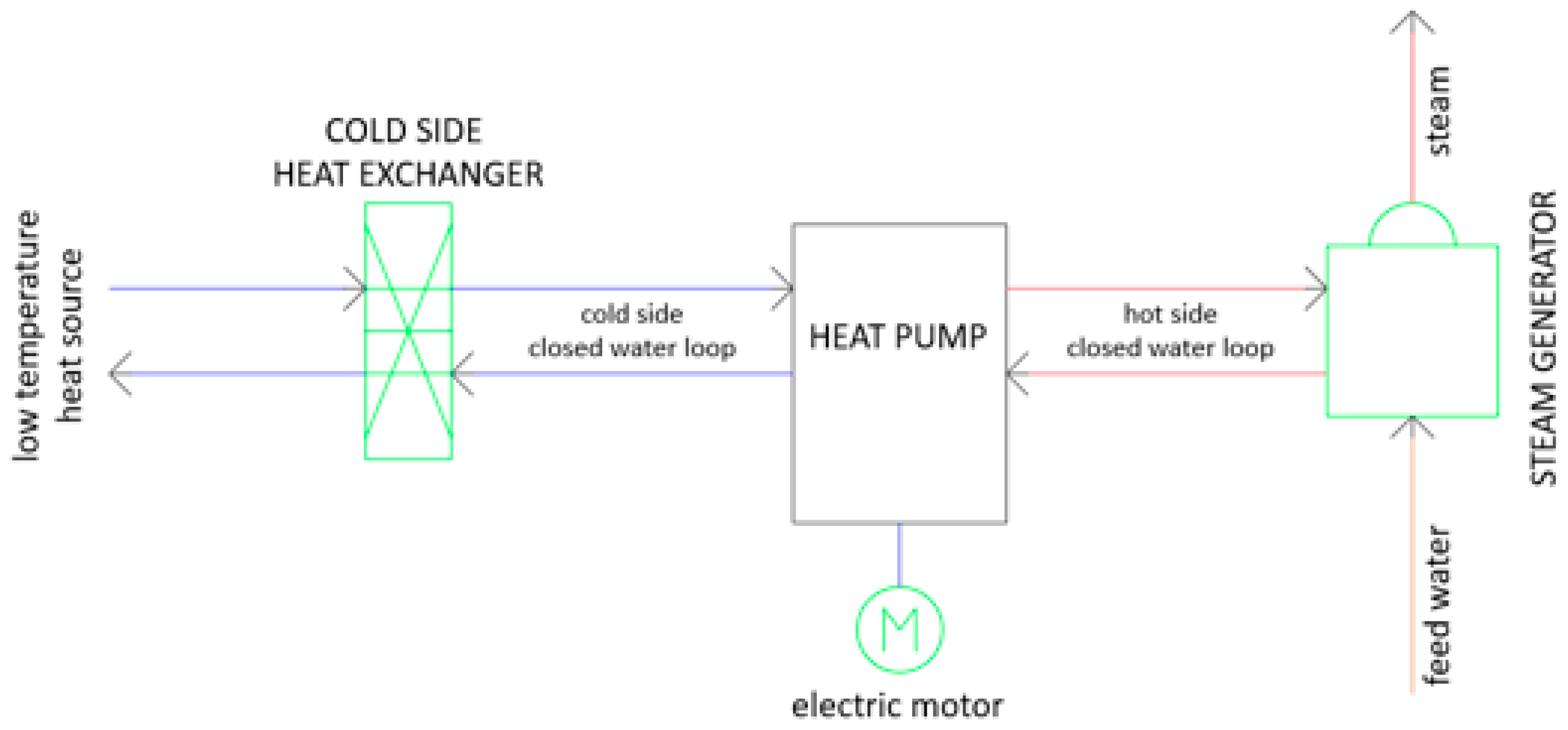

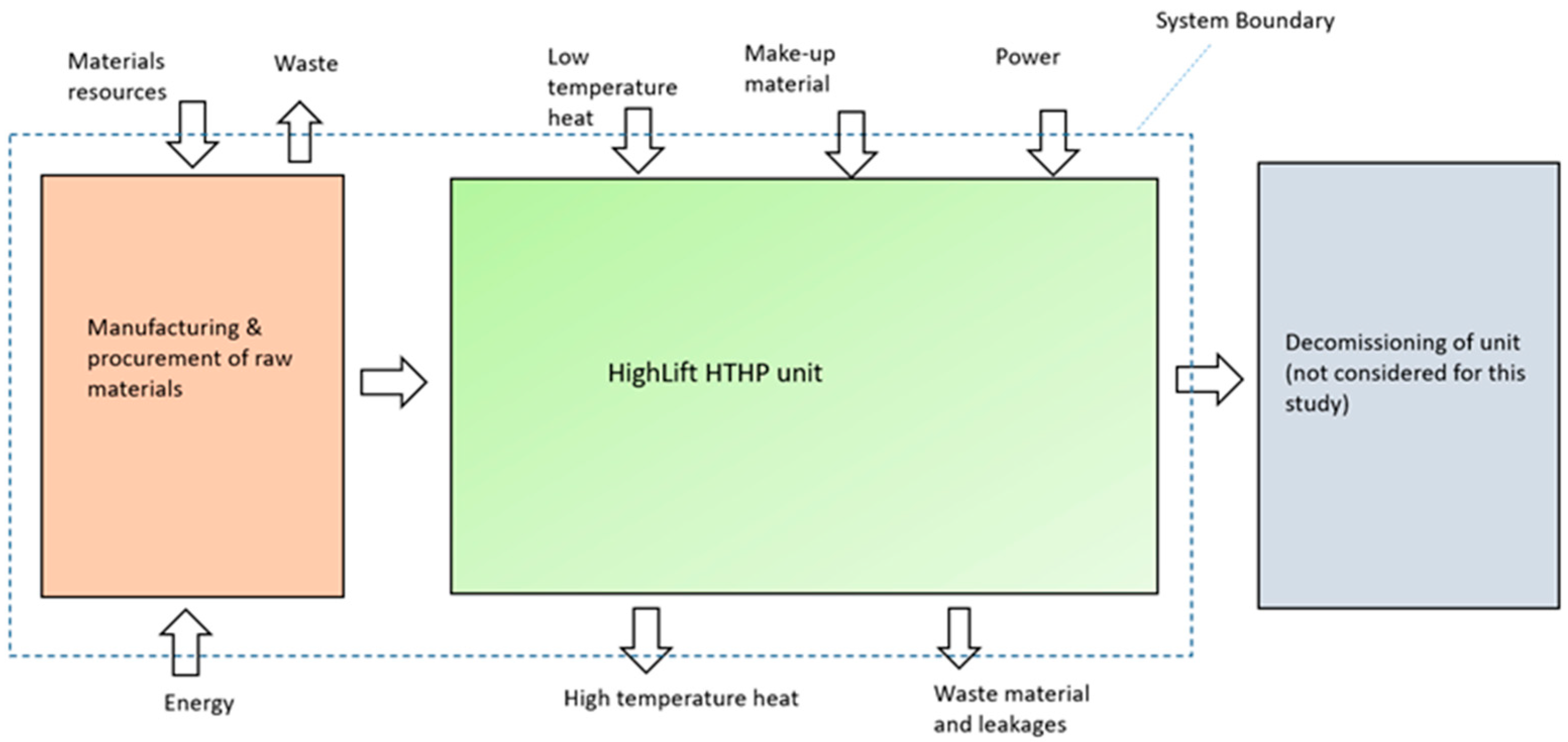
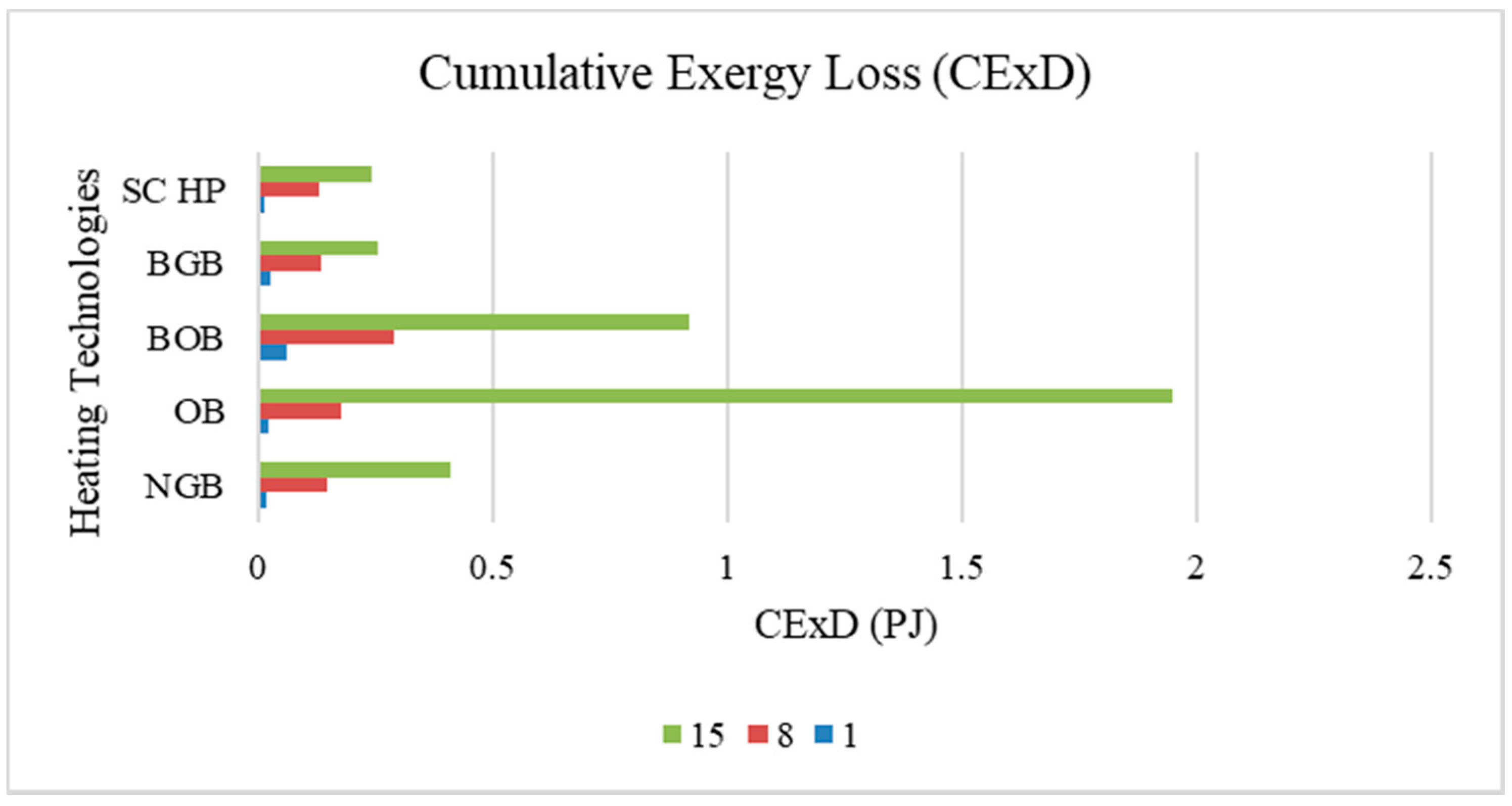
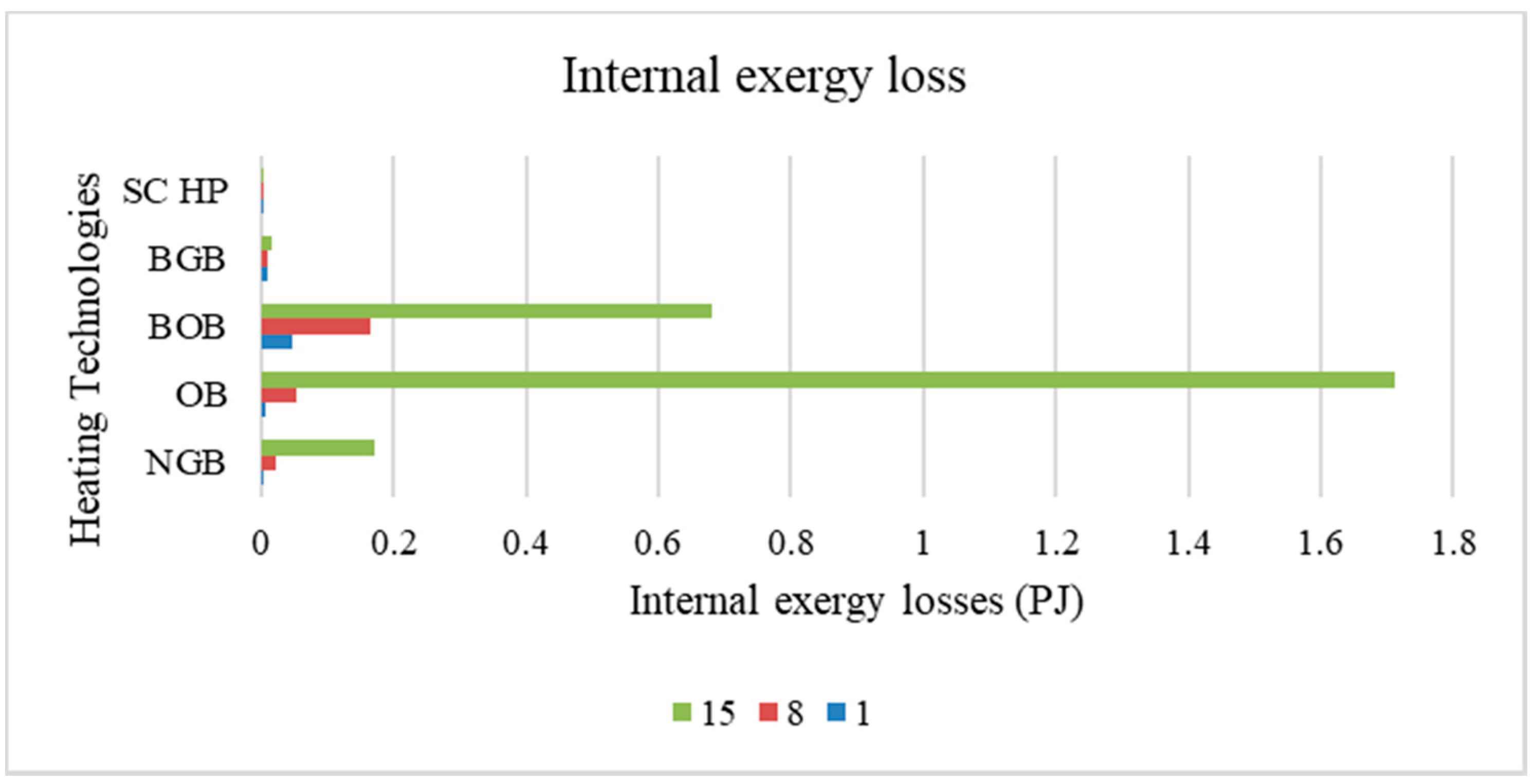

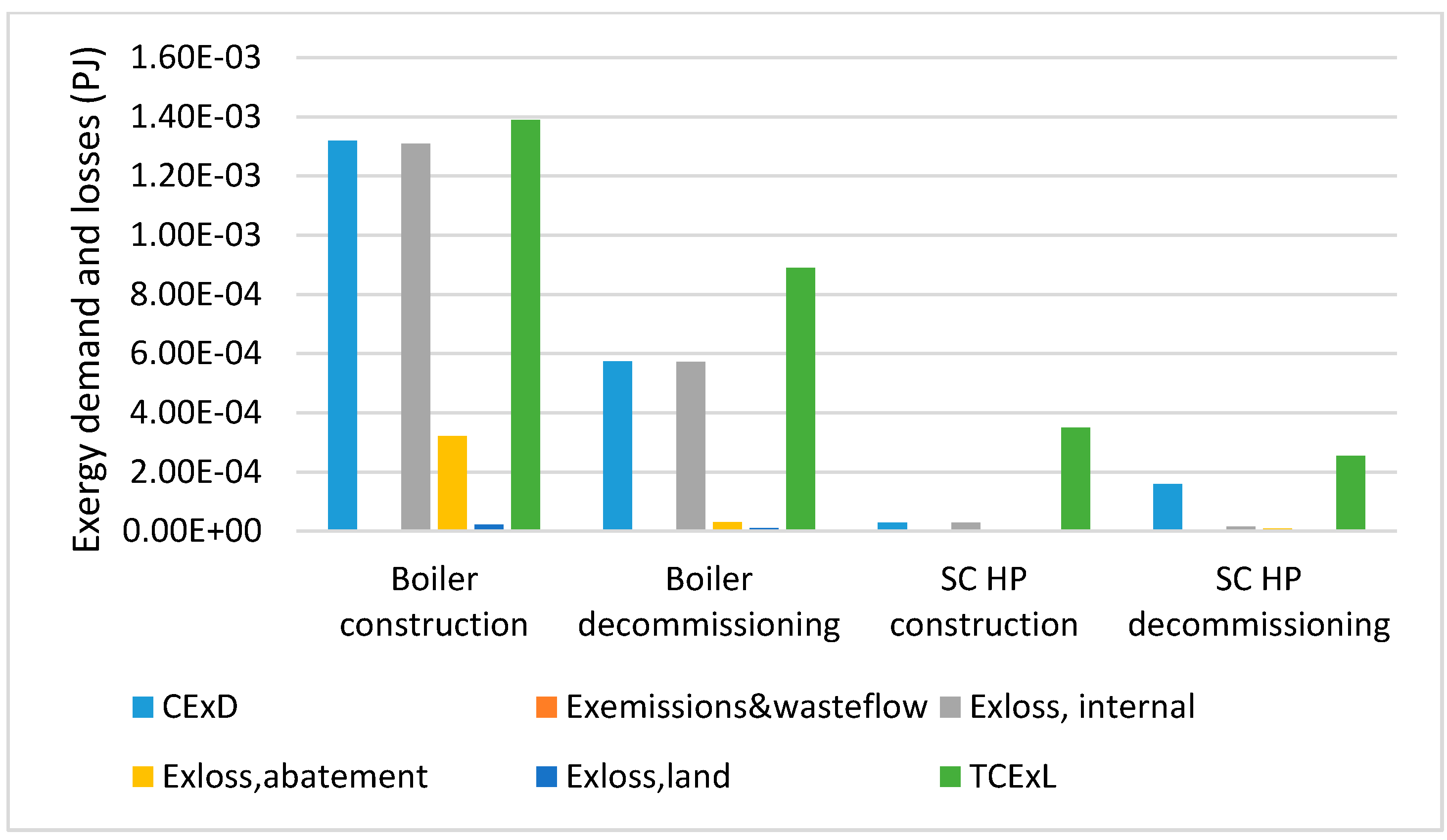
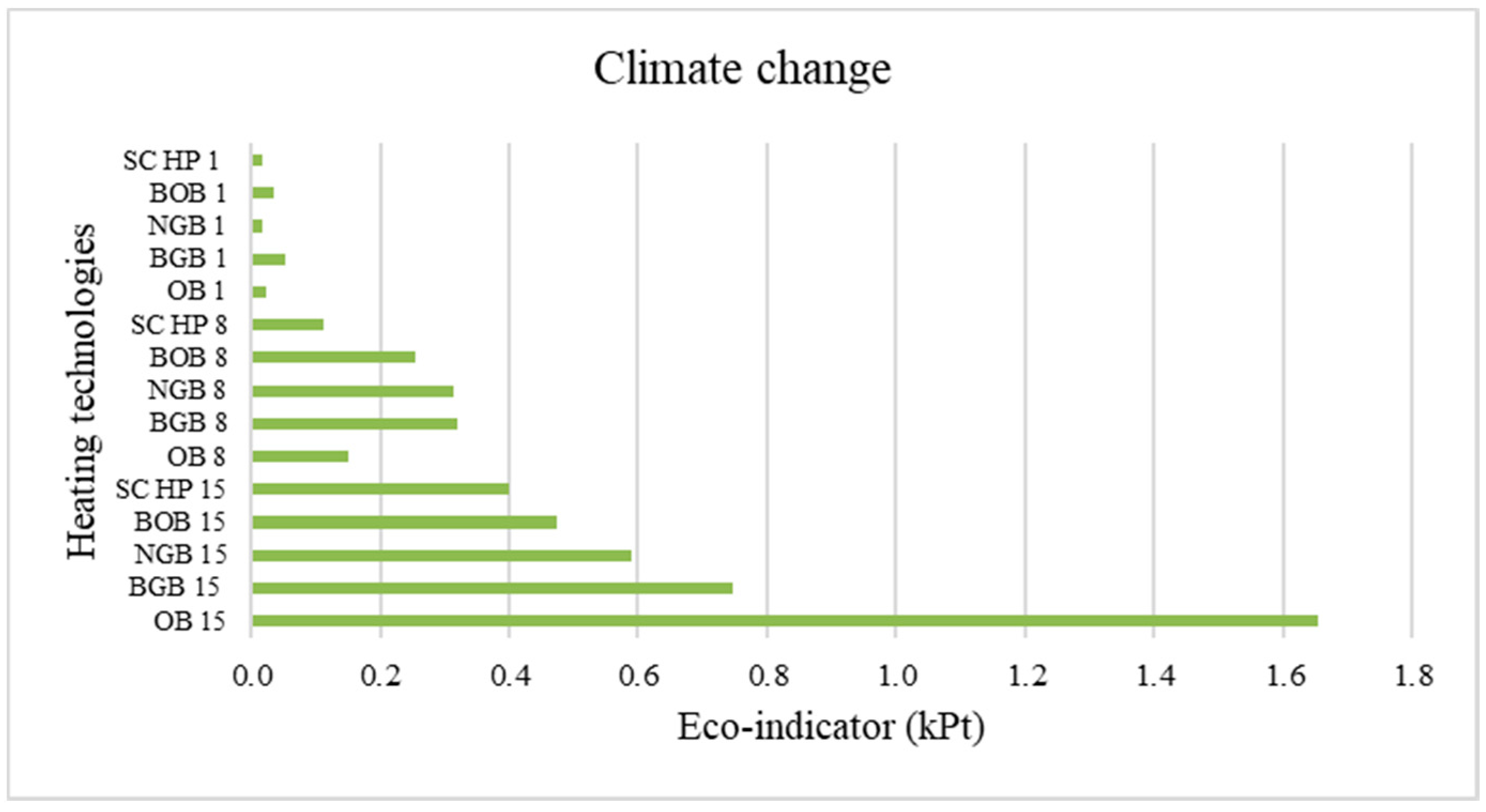

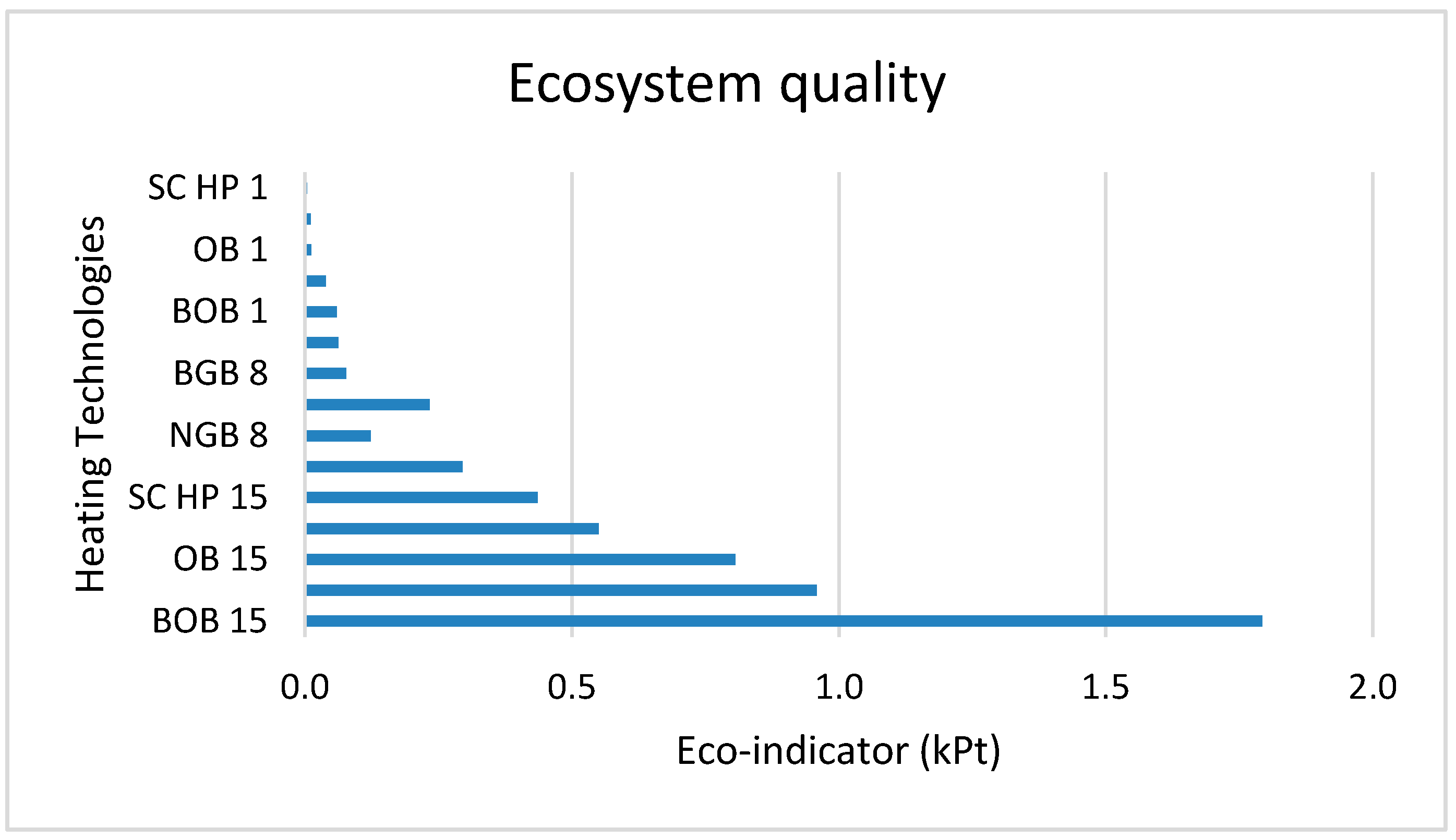

| Construction + 1-Year Operation | ||||||
| Unit | Natural-gas-fired boiler (NGB) | Fossil fuel oil boiler (OB) | Bio-oil boiler (BOB) | Biogas boiler (BGB) | Stirling-cycle-based heat pump (SC HP) | |
| Cumulative exergy demand (CExD) | PJ | 19.9 × 10−3 | 62.4 × 10−3 | 22.9 × 10−3 | 26.0 × 10−3 | 15.2 × 10−3 |
| Exproduct | PJ | 15.0 × 10−3 | 15.0 × 10−3 | 15.0 × 10−3 | 15.0 × 10−3 | 15.0 × 10−3 |
| Exemissions&wasteflow | PJ | 3.60 × 10−6 | 3.70 × 10−6 | 0.57 × 10−6 | 0.10 × 10−6 | 0.28 × 10−6 |
| Exloss,internal | PJ | 4.90 × 10−3 | 7.90 × 10−3 | 47.4 × 10−3 | 11.0 × 10−3 | 0.22 × 10−3 |
| Exloss,abatement | PJ | 14.4 × 10−3 | 0.248 | 1.79 | 7.84 × 10−3 | 78.5 × 10−6 |
| Exloss,land | PJ | 80.4 × 10−6 | 0.28 × 10−3 | 0.63 × 10−3 | 0.28 × 10−3 | 16.0 × 10−6 |
| TCExL | PJ | 19.3 × 10−3 | 0.295 | 17.9 | 19.1 × 10−3 | 0.31 × 10−3 |
| Construction + 8-Year Operation | ||||||
| Unit | NGB | OB | BOB | BGB | SC HP | |
| CExD | PJ | 0.147 | 0.290 | 0.178 | 0.136 | 0.128 |
| Exproduct | PJ | 0.126 | 0.126 | 0.126 | 0.126 | 0.126 |
| Exemissions&wasteflow | PJ | 33.5 × 10−6 | 33.9 × 10−6 | 1.30 × 10−6 | 4.30 × 10−6 | 0.89 × 10−6 |
| Exloss,internal | PJ | 21.0 × 10−3 | 52.0 × 10−3 | 0.164 | 10.1 × 10−3 | 2.00 × 10−3 |
| Exloss,abatement | PJ | 0.115 | 1.98 | 14.3 | 62.7 × 10−3 | 0.17 × 10−3 |
| Exloss,land | PJ | 0.64 × 10−3 | 2.21 × 10−3 | 5.05 × 10−3 | 2.21 × 10−3 | 65.0 × 10−6 |
| TCExL | PJ | 0.136 | 2.15 | 14.3 | 75.0 × 10−3 | 2.24 × 10−3 |
| Construction + 15-Year Operation + Decommissioning | ||||||
| Unit | NGB | OB | BOB | BGB | SC HP | |
| CExD | PJ | 0.409 | 19.5 | 0.918 | 0.254 | 0.240 |
| Exproduct | PJ | 0.237 | 0.237 | 0.237 | 0.237 | 0.237 |
| Exemissions&wasteflow | PJ | 0.33 × 10−3 | 3.31 × 10−3 | 2.10 × 10−6 | 7.65 × 10−6 | 1.50 × 10−6 |
| Exloss,internal | PJ | 0.172 | 1.71 | 0.681 | 17.5 × 10−3 | 3.48 × 10−3 |
| Exloss,abatement | PJ | 0.215 | 3.71 | 26.8 | 0.118 | 0.25 × 10−3 |
| Exloss,land | PJ | 1.21 × 10−3 | 9.46 × 10−3 | 3.55 | 35.5 | 0.12 × 10−3 |
| TCExL | PJ | 0.389 | 8.97 | 6.99 | 3.68 | 3.85 × 10−3 |
| Unit | Boiler Construction | Boiler Decommissioning | HP Construction | HP Decommissioning | |
|---|---|---|---|---|---|
| CExD | PJ | 1.32 × 10−3 | 0.57 × 10−3 | 28.1 × 10−6 | 0.16 × 10−3 |
| Exemissions&waste flow | PJ | 5.01 × 10−6 | 37.5 × 10−9 | 1.61 × 10−9 | 12.3 × 10−9 |
| Exloss,internal | PJ | 1.31 × 10−3 | 0.57 × 10−3 | 28.1 × 10−6 | 15.9 × 10−6 |
| Exloss,abatement | PJ | 32.0 × 10−6 | 30.8 × 10−6 | 0.61 × 10−6 | 9.15 × 10−6 |
| Exloss,land | PJ | 21.7 × 10−6 | 10.1 × 10−6 | 0.11 × 10−6 | 2.84 × 10−6 |
| TCExL | PJ | 1.39 × 10−3 | 0.89 × 10−3 | 0.35 × 10−3 | 0.25 × 10−3 |
Publisher’s Note: MDPI stays neutral with regard to jurisdictional claims in published maps and institutional affiliations. |
© 2021 by the authors. Licensee MDPI, Basel, Switzerland. This article is an open access article distributed under the terms and conditions of the Creative Commons Attribution (CC BY) license (https://creativecommons.org/licenses/by/4.0/).
Share and Cite
Khan, U.; Zevenhoven, R.; Stougie, L.; Tveit, T.-M. Prediction of Stirling-Cycle-Based Heat Pump Performance and Environmental Footprint with Exergy Analysis and LCA. Energies 2021, 14, 8478. https://doi.org/10.3390/en14248478
Khan U, Zevenhoven R, Stougie L, Tveit T-M. Prediction of Stirling-Cycle-Based Heat Pump Performance and Environmental Footprint with Exergy Analysis and LCA. Energies. 2021; 14(24):8478. https://doi.org/10.3390/en14248478
Chicago/Turabian StyleKhan, Umara, Ron Zevenhoven, Lydia Stougie, and Tor-Martin Tveit. 2021. "Prediction of Stirling-Cycle-Based Heat Pump Performance and Environmental Footprint with Exergy Analysis and LCA" Energies 14, no. 24: 8478. https://doi.org/10.3390/en14248478
APA StyleKhan, U., Zevenhoven, R., Stougie, L., & Tveit, T.-M. (2021). Prediction of Stirling-Cycle-Based Heat Pump Performance and Environmental Footprint with Exergy Analysis and LCA. Energies, 14(24), 8478. https://doi.org/10.3390/en14248478







